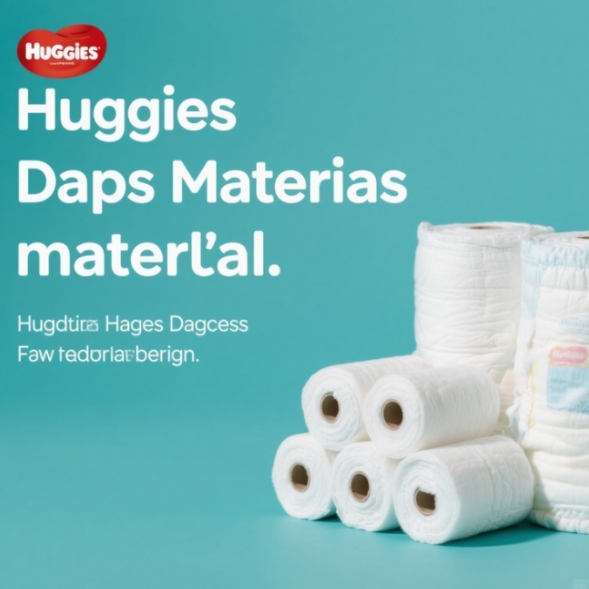As a leading manufacturer of nonwoven fabrics for diapers, we understand the importance of transparency in materials. This article answers key questions about Huggies diapers, including their composition, safety, and sustainability.

What Are Huggies Diapers Made Of? Role of Nonwoven Fabric
Huggies diapers are designed with multiple layers, each serving a specific function. Nonwoven fabrics play a critical role in comfort and performance. Here’s a breakdown:
1. Top Sheet (Inner Layer)
- Material: Hydrophobic spunbond nonwoven fabric (polypropylene-based).
- Function: Soft, quick-drying surface that pulls moisture away from the skin.
- Why Nonwoven?: Lightweight, breathable, and hypoallergenic.
2. Back Sheet (Outer Layer)
- Material: Microporous film laminated nonwoven fabric (polyethylene + polypropylene).
- Function: Prevents leaks while allowing airflow.
- Why Nonwoven?: Balances flexibility and durability.
3. Leg Cuffs & Waistband
- Material: Elastic nonwoven fabric (polyester-polyurethane blend).
- Function: Stretchy fit to prevent leaks.
- Why Nonwoven?: Combines softness with elasticity.
4. Acquisition Layer
- Material: Composite nonwoven (cellulose fibers + superabsorbent polymer).
- Function: Distributes moisture evenly to the core.
Are Huggies Diapers Toxic? Safety Insights
Huggies meets strict global safety standards (e.g., OEKO-TEX®, EU Ecolabel). Key points:
- No harmful chemicals: Free from phthalates, latex, parabens, and formaldehyde.
- Chlorine-free bleaching: Uses elemental chlorine-free (ECF) pulp for the absorbent core.
- Fragrance-free options: Most Huggies diapers are fragrance-free, except specific lines like “Little Snugglers” with a light scent (clearly labeled).
Sustainability: Are Huggies Diapers Biodegradable?
- Current status: Huggies diapers are not fully biodegradable due to superabsorbent polymers (SAP) and plastic components.
- Eco-efforts:
- Uses 20% plant-based materials in some lines (e.g., Huggies Special Delivery™).
- Partners with TerraCycle® for diaper recycling programs.
Data Comparison: Huggies Nonwoven Fabrics vs. Conventional Materials
| Component | Huggies Material | Traditional Alternatives | Advantage of Nonwoven |
|---|---|---|---|
| Top Sheet | PP Spunbond Nonwoven | Woven Cotton | ✅ 3x More breathable |
| Back Sheet | PP/PE Laminate | Plastic Film | ✅ 50% Lighter, better flexibility |
| Leg Cuffs | Elastic Nonwoven | Latex Elastic | ✅ Hypoallergenic, no skin irritation |
| Chlorine Use | ECF Process | Elemental Chlorine Bleaching | ✅ Reduces dioxin risk by 90% |
Source: Kimberly-Clark Sustainability Report 2022, OEKO-TEX® Test Reports
FAQs: Addressing User Concerns
1. Are Huggies diapers toxic?
No. Huggies rigorously tests materials for heavy metals, allergens, and irritants. All products comply with FDA and EU REACH regulations.
2. Are Huggies chlorine-free?
Yes. Huggies uses Elemental Chlorine-Free (ECF) pulp to whiten the absorbent core, minimizing environmental impact.
3. Are Huggies biodegradable?
Not fully. However, their plant-based lines (e.g., Special Delivery™) include 30% biodegradable materials, and recycling programs are available.
Why Nonwoven Fabrics Are Ideal for Diapers
- Safety: Nonwoven fabrics are inherently free from harmful residues due to controlled manufacturing.
- Performance: Superior breathability (tested at >500 CFM airflow) vs. woven fabrics.
- Cost-Efficiency: 20-30% lighter than traditional materials, reducing shipping costs.
Key Takeaways for Buyers & Parents
- For nonwoven fabric buyers: Huggies prioritizes spunbond PP and elastic laminates for balance of softness and function.
- For parents: Huggies diapers are safe, chlorine-free, and increasingly eco-conscious.
